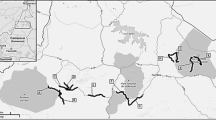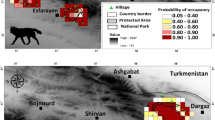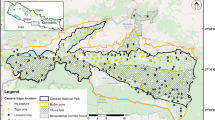Abstract
We conducted spotlight counts from 1992 to 2006 in 59 localities to describe carnivore presence, distribution and relative abundance in open agriculture lands in Aragon, northeastern Spain. During the study period, urban waste and carcases of domestic livestock became less available to wild animals, and rabbit (Oryctolagus cuniculus) abundance was low after rabbit haemorragic disease. We calculated a kilometric abundance index (KAI, individuals seen per 100 km surveyed) and the ratio between the number of positive localities in which a species was detected and the total of localities surveyed in a year. Indices to abundance and presence included: red fox (Vulpes vulpes), KAI per 100 km 10.70 and 100.0% localities per year; stray dog (Canis familiaris), KAI 0.48 and 22.6% localities; wildcat (Felis silvestris), KAI 0.10 and 19.1% localities; domestic cat (Felis catus), KAI 0.21 and 20.6% localities; polecat (Mustela putorius), KAI 0.02 and 2.0% localities; badger (Meles meles), KAI 0.16 and 23.6% localities; stone marten (Martes foina), KAI 0.11 and 19.6% localities; weasel (Mustela nivalis), KAI 0.002 and 0.6% localities; and genet (Genetta genetta), KAI 0.06 and 10.0% localities. Indices of badger abundance increased significantly, whereas indices of stray dogs decreased significantly over the study period. Abundance indices of red fox, the most important predator of small game, were stable throughout the study period. No significant trend was observed to other studied species. This study concludes that Aragon region maintains a diverse and rather stable carnivore community and shows that large scale data may help to identify trends of the more abundant wild and feral carnivores.

Similar content being viewed by others
References
Blaum N, Rossmith E, Popp A, Jeltsch F (2007) Shrub encroachment affects mammalian carnivore abundance and species richness in semiarid rangelands. Acta Oecol 31:86–92. doi:10.1016/j.actao.2006.10.004
Buckland ST, Anderson DR, Burnham KP, Laake JL, Borchers DL, Thomas L (2004) Advanced distance sampling. Oxford University Press, Oxford
Cliquet F, Combes B, Barrat J (2006) Means used for terrestrial rabies elimination in France and policy for rabies surveillance in case of re-emergence. Dev Biol 125:119–126
Delibes-Mateos M, Fernández de Simon F, Villafuerte R, Ferreras P (2008) Feeding responses of the red fox (Vulpes vulpes) to different wild rabbit (Oryctolagus cuniculus) densities: a regional approach. Eur J Wildl Res 54:71–78 doi:10.1007/s10344-007-0111-5
Gortázar C (1997) Relative abundance wild rabbit (Oryctolagus cuniculus) and red fox (Vulpes vulpes) after rabbit haemorrhagic disease (RHD) in the Central Ebro Bassin in Northeastern Spain. Z Jagdwiss 43:259–265. doi:10.1007/BF02239892
Gortázar C, Villafuerte R, Blanco JC, Fernández de Luco D (1998) Enzootic sarcoptic mange in red foxes in Spain. Z Jagdwiss 44:251–256. doi:10.1007/BF02242030
Gortázar C, Acevedo P, Ruiz-Fons F, Vicente J (2006) Disease risks and overabundance of game species. Eur J Wildl Res 52:81–87. doi:10.1007/s10344-005-0022-2
Harrington LA, Harrington AL, Macdonald DW (2008) Estimating the relative abundance of American mink Mustela vison on lowland rivers: evaluation and comparison of two techniques. Eur J Wildl Res 54:79–87. doi:10.1007/s10344-007-0114-2
Hounsome TD, Young RP, Davison J, Yarnell RW, Trewby ID, Garnett BT, Delahay RJ, Wilson GJ (2005) An evaluation of distance sampling to estimate badger (Meles meles) abundance. J Zool (Lond) 266:81–87. doi:10.1017/S0952836905006606
Krebs JR (1997) Bovine tuberculosis in catle and badgers. Report to the Rt Hon. Dr Jack Cunningham MP. The Ministry of Agriculture, Fisheries and Food, London
Kruuk H, Parish T, Brown CAJ, Carreara J (1979) Use of pasture by the European badger (Meles meles). J Appl Ecol 16:453–459. doi:10.2307/2402521
Lachat PN, Aubry S, Ferrari N, Meia JS, Mermod C, Weber JM (1993) Effectifs et activities du chat domestique (Felis catus) dans le Jura suise. Z Saugetierkd 58:84–91
Lancia RA, Nichols JD, Pollock KH (1994) Estimating the number of animals in wildlife populations. In: Bookhout TA (ed) Research and management techniques for wildlife and habitats. The Wildlife Society, Bethesda, pp 215–253
Macdonald DW, Newman C (2002) Population dynamics of badgers (Meles meles) in Oxfordshire, UK: numbers, density and cohort life histories, and a possible role of climate change in population growth. J Zool (Lond) 256:121–138
Millán J, Gortázar C, Marco J, Escudero MA (2001) Carnívoros detectados mediante recorridos nocturnos en Aragón. Galemys 13:25–36
Newsome AE, Parer I, Catling PC (1989) Prolonged prey suppression by carnivores-predator-removal experiments. Oecologia 78:458–467. doi:10.1007/BF00378734
Palomo LJ, Gisbert J (2002) Atlas de mamíferos terrestres de España. Dirección General de Conservación de la Naturaleza-SECEM-SECEMU, Madrid
Pandolfi M, Santolini R, Bonacoscia M (1991) Spotlight census of the red fox (Vulpes vulpes) and the domestic cat (Felis catus) in three sample areas of the Marches region (central Italy). Hystrix 3:221–22
Panek M, Bresinski W (2002) Red fox Vulpes vulpes density and habitat use in a rural area of western Poland in the end of 1990s, compared with the turn of 1970s. Acta Theriol (Warsz) 47:433–442
Reynolds JC, Tapper SC (1995) The ecology of the red fox Vulpes vulpes in relation to small game in rural Southern England. Wildl Biol 1:105–119
Roboly O (1985) Study on the populations of some wild or roaming canids during night shooting. Rev Ecol (Terre Vie) 40:187–188
Ruette S, Stahl P, Albaret M (2003) Applying distance-sampling methods to spotlight counts of red foxes. J Appl Ecol 40:32–43. doi:10.1046/j.1365-2664.2003.00776.x
Sadlier AMJ, Webbon CC, Baker PJ, Harris S (2004) Methods of monitoring red foxes Vulpes vulpes and badgers Meles meles: are field signs the answer? Mammal Rev 34:75–98. doi:10.1046/j.0305-1838.2003.00029.x
Short J, Turner B, Risbey DA, Carnamah R (1997) Control of feral cats for nature conservation. II. Population reduction by poisoning. Wildl Res 24:703–714. doi:10.1071/WR96071
Sobrino R, Gonzalez LM, Vicente J, de Luco DF, Garate T, Gortázar C (2006) Echinococcus granulosus (Cestoda, Taeniidae) in the Iberian wolf. Parasitol Res 99:753–756. doi:10.1007/s00436–006–0229–5
Sobrino R, Arnal MC, Luco DF, Gortázar C (2008a) Prevalence of antibodies against canine distemper virus and canine parvovirus among foxes and wolves from Spain. Vet Microbiol 126:251–256. doi:10.1016/j.vetmic.2007.06.014
Sobrino R, Ferroglio E, Oleaga A, Romano A, Millan J, Revilla M, Arnal MC, Trisciuoglio A, Gortázar C (2008b) Characterization of widespread canine leishmaniasis among wild carnivores from Spain. Vet Parasitol 155(3–4):198–203
Sobrino R, Martín-Hernando MP, Vicente J, Aurtenetxe O, Garrido JM, Gortázar C (2008c) Bovine tuberculosis in a badger (Meles meles) from Spain. Vet Rec 163(5):159–160
Sokal R, Rohlf FJ (1981) Biometry. Freeman, San Francisco
Sterner RT, Smith GC (2006) Modelling wildlife rabies: transmission, economics, and conservation. Biol Conserv 131:163–179. doi:10.1016/j.biocon.2006.05.004
Travaini A, Delibes M, Ferreras P, Palomares F (1997) Diversity, abundance or rare species as a target for the conservation of mammalian carnivores: a case study in Southern Spain. Biodivers Conserv 6:529–535. doi:10.1023/A:1018329127772
Vincent JP, Gaillard JM, Bideau E (1991) Kilometric index as biological indicator for monitoring forest roe deer populations. Acta Theriol (Warsz) 36:315–328
Weber JM, Aubry S, Lachat N, Meia JS, Mermod C, Parate A (1991) Fluctuations and behaviour of foxes determined by nightlighting. Preliminary results. Acta Theriol (Warsz) 36:285–291
Wemmer C, Kunz TH, Lundie-Jenkins G, McShea WJ (1996) Mammalian sign. In: Wilson DE, Cole FR, Nichols JD, Rudran R, Foster MS (eds) Measuring and monitoring biological diversity. Smithsonian Institution, Washington DC, pp 157–176
Williams D, Acevedo P, Gortázar C, Escudero MA, Labarta JL, Marco J, Villafuerte R (2007) Hunting for answers: rabbit (Oryctolagus cuniculus) population trends in northeastern Spain. Eur J Wildl Res 53:19–28 doi:10.1007/s10344-006-0056-0
Williams E, Barker IK (2001) Infectious diseases of wild mammals. Iowa State University Press, Iowa
Zabala J, Zuberogoitia I, Martinez-Climent JA (2005) Site and landscape features ruling the habitat use and occupancy of the polecat (Mustela putorius) in a low density area: a multiscale approach. Eur J Wildl Res 51:157–162. doi:10.1007/s10344-005-0094-z
Acknowledgements
We are indebted to two anonymous referees whose comments greatly improved the quality of the paper. We thank Rangers of the Fish and Game Service, Aragón Government, and with the staff of Ebronatura. We thank F. Ruiz-Fons for helpful advice and English revision. RS has a Ph.D. grant from Junta de Comunidades de Castilla-La Mancha, and PA is currently enjoying a Juan de la Cierva research contract awarded by the Ministerio de Educación y Ciencia (MEC).
Author information
Authors and Affiliations
Corresponding author
Additional information
Communicated by W. Lutz
Rights and permissions
About this article
Cite this article
Sobrino, R., Acevedo, P., Escudero, M.A. et al. Carnivore population trends in Spanish agrosystems after the reduction in food availability due to rabbit decline by rabbit haemorrhagic disease and improved waste management. Eur J Wildl Res 55, 161–165 (2009). https://doi.org/10.1007/s10344-008-0230-7
Received:
Revised:
Accepted:
Published:
Issue Date:
DOI: https://doi.org/10.1007/s10344-008-0230-7




